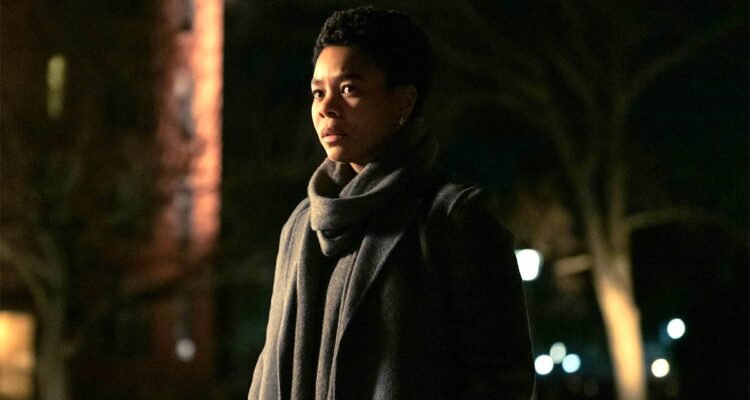Centuries-old grandiose red brick, white-trimmed buildings fill the frame at the start of Mariama Diallo’s striking debut feature film “Master.” Ivy-clad collegiate walls are a staple in the horror genre; the grounds are confined, and there’s something inherently creepy about old buildings. But here, Diallo uses this setting not just for aesthetic frights but because it is these very venerated walls from which the terror at the center of her story finds its origin.
Gail Bishop (a stellar Regina Hall) is the first Black Master, a term that will take on many meanings as the film progresses at the fictional New England college Ancaster. As old as the country itself, the college claims a few presidents and senators amongst its alumni. Ancaster is haunted not only by the ghosts of its very discriminatory past — as seen in the specter-like marble bust in Gail’s home or the many creepy paintings of prominent dead white people who founded the institution — but supposedly also by the literal ghost of a witch hung on the grounds centuries ago. Campus legend has it at 3:33 am every year on the anniversary of her death, the witch takes the life of a freshman student.
READ MORE: Sundance 2022 Preview: 20 Must-See Movies From The Festival
This year, it seems her target may be Jasmin (Zoe Renee, “Jinn”), one of apparently eight Black students enrolled at the college, who has the bad luck of being assigned the supposedly haunted room 302. A valedictorian from the suburbs of Tacoma, Washington, at first, Jasmin is all smiles and wonder as she embraces her academic future. But as microaggressions mount from faculty, staff, and students alike, she becomes more closed off, unable to fully open herself up to the fun collegiate experience of her peers.
Part of Jasmin’s struggles stems from a disagreement with her literature professor Liv (a sly Amber Gray, “The Underground Railroad”), who dismisses her contributions in class and then gives her an F on a well-written paper about Nathaniel Hawthorne’s “The Scarlet Letter” because she failed to examine the book from a Critical Race Theory lens. One of the only other Black faculty members, Liv’s chance at tenure comes under scrutiny when Jasmin files a grievance over the grade.
Gail manages this thorny situation in her department while also settling into her new home, where eerie things are starting to happen. Maggots appear at random. She finds a creepy photograph of previous tenants; their Black maid obscured in the background. She also finds other racist objects like phrenology diagrams and anti-Black Jim Crow era figurines. The more she attempts to ignore the implications of these innocuous yet loaded tokens, the more she begins to break from reality, with nightmares creeping into her waking hours. It’s hard to focus on your job when the very grounds in which you work and live are filled with reminders that you’re not truly welcome there.
Meanwhile, as Jasmin becomes obsessed with investigating the story of how the first Black woman student enrolled on campus died mysteriously by hanging in the 1960s, she finds herself haunted by nightmares of the witch, while also physically threatened with a noose on her door. The weight of Jasmin’s internal breakdown plays out on Renee’s expressive face. Watching her fold in on herself is nothing short of heartbreaking. Her smile slowly morphing into an omnipresent frown, her bright, curious eyes dulling.
Diallo deftly weaves in more subtle yet insidious terrors as these visceral attacks escalate. Despite publishing multiple books and academic papers, Gail’s individual identity is practically erased in her new position. Fellow factuality members refer to her as “Barack,” a nod to her being the first Black woman to hold this esteemed position at the college. Later while writing a speech seeking contributions from donors, she’s instructed to refer to herself as a “women of color” rather than a Black woman. While there may be a literal witch haunting these two women, the psychological horrors of being a Black woman in a system that cannot even see their individuality proves to be an equally painful experience.
The dark, evocative cinematography from Charlotte Hornsby (“Madeline’s Madeline,” “Hair Wolf”) magnifies the absolutely spectral shadows that seem to be pervasive amongst the college’s cold brick buildings. While the spooky percussion-laden score by Robert Aiki Aubrey Lowe (“Candyman”) swirls as it envelopes the atmosphere, mirroring the psychological breakdown these women are headed towards.
After the film’s devastating climax — which may be triggering for some — Hall gives an impassioned speech that showcases her true range as a dramatic actress, conjuring a deep well of complex emotions as all the frustrations that Gail has suppressed through her entire academic career bubble to the surface. She masterfully cracks the facade behind which these well-meaning liberal academics who pat themselves on the back for their lip service “radical inclusion” measures hide.
While there are shades of Jordan Peele’s “Get Out” and even “The Shining” in the film’s DNA, Diallo has crafted an incisive, intelligent, and stridently political horror film that is distinctly all her own. The terror at the heart of this film reverberates far beyond the myths of this academic institution. “Master” excavates the very roots of our country’s foundation and dares us to face the haunted ground on which it is built. [A-]
Follow along with all our coverage of the 2022 Sundance Film Festival.

